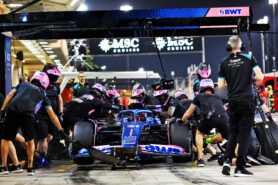Pit stop

Esteban Ocon (FRA) Alpine F1 Team A523 practices a pit stop. Formula One Testing, Day One, Thursday 23rd February 2023. Sakhir, Bahrain.
A pit stop is a crucial component of a Formula 1 race, and it refers to the process in which a team of mechanics services the car of a driver during the race. The pit stop is a mandatory aspect of every F1 race and can vary in length, depending on the type of service required.
During the pit stop, the driver pulls into the pit lane, and the car is directed to the designated pit box. The pit crew then proceeds to work on the car, performing various tasks such as changing tires, refuelling, and making repairs if necessary. The time taken for the pit stop can range from just a few seconds to over a minute, depending on the work needed.
One of the most critical aspects of the pit stop is the speed at which it is executed. A well-executed pit stop can give a driver a significant advantage over their competitors by saving them valuable time. As a result, teams have to practice and refine their pit stop procedures to ensure that they can complete the process as quickly and efficiently as possible.
Pit stops can also be used as a strategic tool during the race. Teams may opt to make pit stops at different times to gain an advantage over their competitors. Factors such as tire wear, fuel consumption, and track conditions all play a part in determining the optimal pit stop strategy.
In summary, a pit stop is a critical element of Formula 1 racing, and it involves a team of mechanics servicing the car of a driver during the race. The speed and efficiency of the pit stop can be a determining factor in the race's outcome, making it a crucial aspect for teams to get right.











LAST 3 F1 Fan COMMENTS